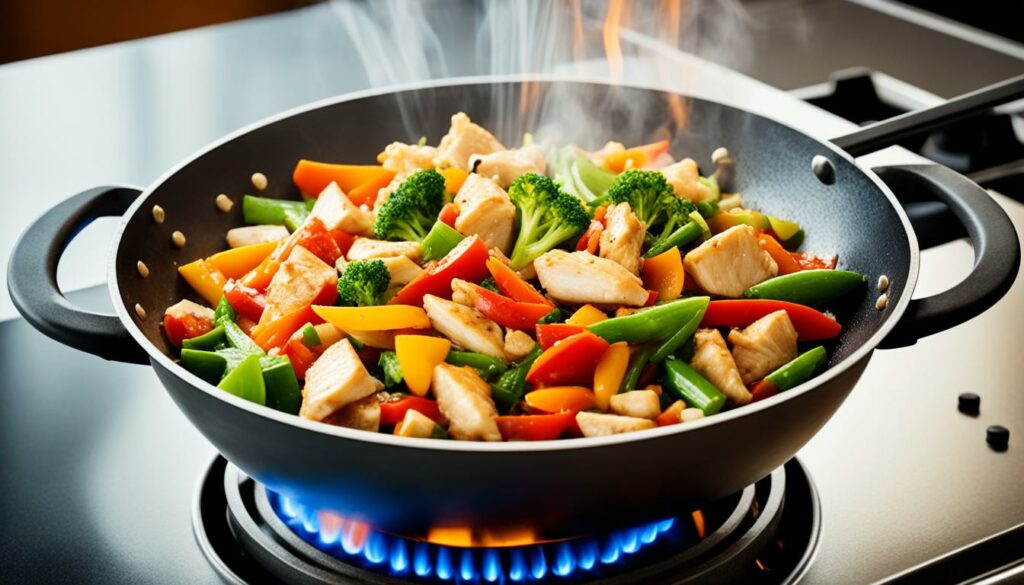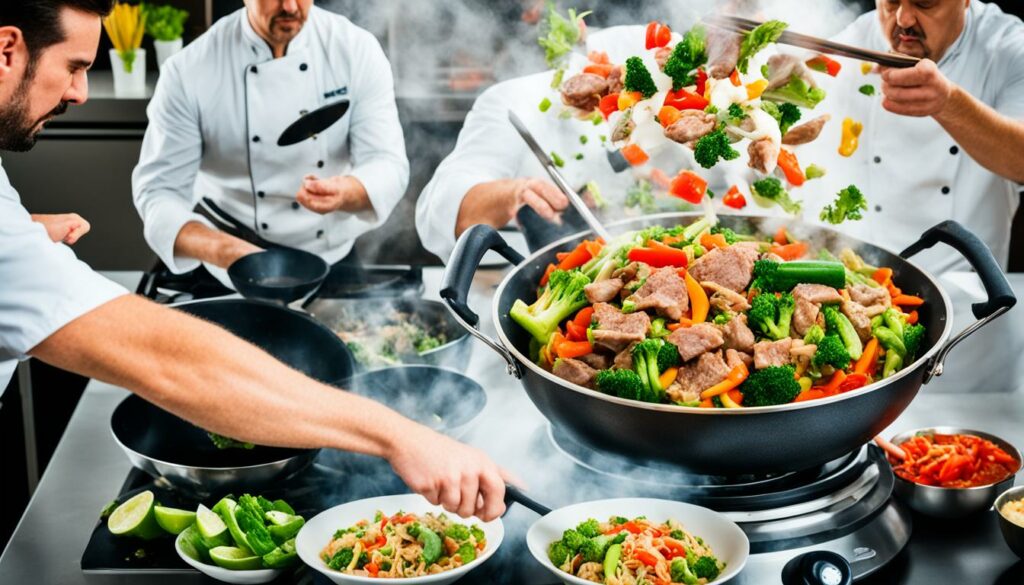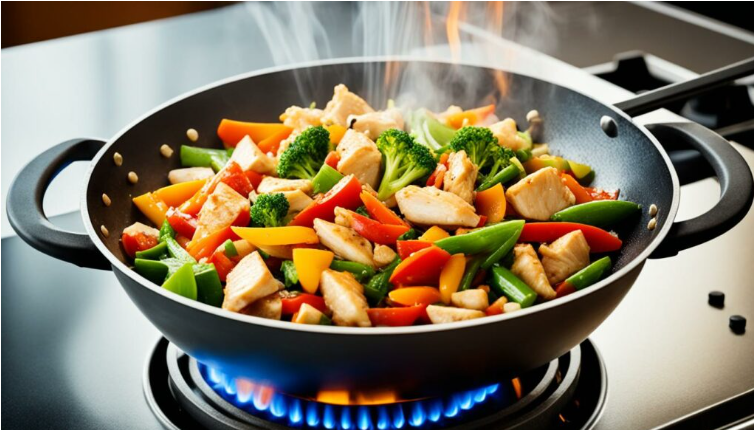Woks are key for quick stir-frying, making cooking efficient and flavorful. Learning to cook with a wok is more than just a skill. It’s about the history and evolution of stir-frying. This article covers the history of wok cooking and tips to improve your stir-fry skills.
The stir-frying technique started in the Eastern Zhou period (771-256 BC). It became a mainstay in kitchens worldwide, with millions of meals cooked daily in Asia12. I’ll share tips on using woks to make your stir-fries better.
With the right wok and approach, anyone can enjoy stir-frying at home. We’ll look at important ingredients and techniques for tasty stir-fries. Let’s start this tasty journey together!
Key Takeaways
- Woks are indispensable for quick and flavorful stir-frying.
- The history of stir-frying spans over two millennia, deeply entrenched in Asian cooking traditions.
- Stir-frying utilizes the efficient heat distribution of woks for rapid cooking.
- Every household should consider investing in a quality wok for versatile meal preparation.
- Understanding how to season and maintain your wok can enhance its flavor-giving qualities.
- Using fresh ingredients and aromatics is key to elevating your stir-fry dishes.
- Mastering wok cooking techniques will lead to a more authentic culinary experience.
The History of Stir-frying and Its Evolution
The history of stir-frying is a story of transformation from ancient China to global fame. This cooking method has changed a lot over time. It was shaped by cultural exchanges and new ideas.
Origins of Stir-frying in Ancient China
Stir-frying started over 2,000 years ago with the use of woks in Chinese cooking. It was first mentioned in the 6th century AD, but it wasn’t as popular as boiling or steaming back then because oil was expensive3. During the Song Dynasty (960–1279), metal woks became common. This led to a new way of cooking that quickly heated food and kept flavors in4. By the late Ming Dynasty (1368–1644), stir-frying grew more popular as fuel prices went up, making quick cooking necessary3.
How Stir-frying Became Popular Worldwide
Chinese immigrants brought stir-frying to the West in the 19th century. The term “stir fry” became known after the 1945 book *How To Cook and Eat in Chinese*3. The health movement of the 1970s made stir-frying popular in the West for its quick cooking and fresh tastes3. Now, woks are a key item in kitchens everywhere, using modern materials like stainless steel and non-stick coatings while keeping their traditional cast iron roots4.
| Period | Key Developments | Cultural Impact |
|---|---|---|
| 6th Century AD | First references to stir-frying | Primarily overshadowed by boiling and steaming |
| Song Dynasty (960–1279) | Rise of metal woks | New approaches to rapid cooking |
| Late Ming Dynasty (1368–1644) | Increased popularity of stir-frying | Adaptation to rising fuel costs |
| 19th Century | Introduction of stir-frying in the West | Cultural exchange and adaptation in new cuisines |
| 1970s | Health-conscious movements | Widespread acceptance and popularity of stir-frying |
The evolution of stir-frying shows how it moved from Chinese roots to a worldwide favorite. This change reflects big shifts in both food and culture that have shaped our eating habits today.
Why Woks are Essential for Quick Stir-frying
I love how woks change the game in the kitchen. Their shape makes tossing ingredients quick and creates perfect heat spots for cooking. You can stir-fry, deep-fry, or steam with them, showing their many uses. For over 2,000 years, woks have been key in Asian cooking, mixing old ways with new by fitting many dishes and methods5.
The Unique Design of Woks
The round base and wok ring let you cook at different temperatures. At high heat, food moves up the sides, creating hot and cool spots. This makes woks great for quick cooking because they’re light and easy to move around6.
Heat Distribution and Cooking Zones
Woks spread heat well for stir-frying. Their tall sides and deep shape stop food from splattering. This makes them good for many cooking methods, like braising and boiling. They cook food efficiently and add a smoky taste, known as “wok hei,” which is a key part of Asian cooking56.
| Feature | Wok | Frying Pan |
|---|---|---|
| Shape | Concave | Flat |
| Cooking Techniques | Stir-frying, deep-frying, steaming | Sautéing, shallow frying |
| Heat Distribution | Variable zones | Even |
| Cooking Speed | Fast | Moderate |
| Flavor Contribution | Wok hei | Browning |
Key Ingredients for Delicious Stir-fries
Choosing the right ingredients is key to a great stir-fry. I always pick fresh veggies and quality proteins for the best taste and texture. Freshness is crucial for a dish that stands out.
Choosing Fresh Ingredients
I go for colorful veggies like broccoli, bell peppers, and snap peas. They look great and are full of nutrients. Proteins like beef, chicken, and shrimp add flavor and fill you up. For vegetarians, tofu or tempeh are great choices7. Making sure all ingredients are cut the same helps them cook evenly for a perfect stir-fry.
Enhancing Flavor with Aromatic Spices
Garlic and ginger are my go-to spices for flavor. Fresh ginger adds a special warmth to dishes. It’s important not to fill the wok too much, as it can cool down and prevent a good sear8. Sauces like soy sauce or Teriyaki add moisture and depth, making the dish more enjoyable.
Using Fresh Ginger in Stir-fries
Fresh ginger is essential in my stir-fries. Its unique taste makes the dish richer. I slice it thin so its flavor spreads out well. Marinating proteins with ginger improves their taste, texture, and keeps juices in89. This creates a complex flavor that really excites your taste buds.
| Ingredient Type | Examples | Notes |
|---|---|---|
| Proteins | Beef, Chicken, Shrimp, Tofu, Tempeh | Choose based on personal preference and dietary needs. |
| Vegetables | Broccoli, Bell Peppers, Snap Peas, Carrots | Colorful choices increase visual appeal and nutrition. |
| Aromatics | Garlic, Fresh Ginger, Green Onions | Add depth and richness to the stir-fry. |
| Sauces | Soy Sauce, Teriyaki | Provide moisture and flavor enhancement. |
Cooking Techniques for Mastering Stir-frying
To get the best out of stir-frying, it’s key to know the right wok cooking techniques. These methods can greatly improve your dishes and boost your kitchen skills. A top technique is the “hot wok, cold oil” method. This means heating the wok to a high temperature before adding oil. This makes the wok nonstick and helps cook food evenly, giving veggies and proteins a perfect texture.
Wok Cooking Techniques
Learning various wok cooking techniques can make your stir-fries tastier and crisper. The right mix of meat and veggies is important. For example, beef and broccoli should be 1:1, while sweet and sour pork can be 2:1. Shrimp and veggie stir-fries often have more veggies, and adding rice or noodles should be balanced at 1:1:110.
Choosing the right oil is key for great stir-fries. Peanut oil is best because it can get very hot, making food sear well and taste great11. Don’t use olive oil or butter because they burn easily. Preheat your wok well; when water droplets evaporate fast, it’s ready for stir-frying11.
Keep the heat high and don’t overcrowd the wok to avoid a slow cook. Getting to know these techniques will make cooking easier and tastier.
The Importance of “Hot Wok, Cold Oil”
The “hot wok, cold oil” method stops food from sticking and helps with quick searing. It keeps your stir-fries crunchy and cooked right. Prepare your ingredients before starting, as stir-frying is fast and requires planning. A seasoned wok gets even tastier over time, adding to your dishes’ flavor11.

Essential Tools for Efficient Stir-frying
Choosing the right tools is key to perfect stir-frying. The best woks ensure your ingredients cook evenly and keep their flavor. I suggest starting with carbon steel woks for their great heat retention and quick response. For kitchens without special wok burners, a flat-bottomed wok is a smart choice. I also look at other pans like heavy-duty skillets for great results. But, nothing beats the real deal of a classic wok.
Best Woks for Stir-frying
The Dalstrong brand is a standout among woks. Their woks are known for excellent conductivity and even heat distribution. They come with an ETERNA non-stick coating for easy cleaning and durability. Sizes range from 9″ to 12″, offering flexibility for various cooking tasks. Plus, their ergonomic handles make cooking comfortable.
Alternative Stir-fry Pan Options
Looking beyond woks, there are many other options. The Yosukata 14-Inch Carbon Steel Wok heats up fast, perfect for stir-frying. It’s priced at $65 but is now $60. The Joyce Chen Carbon Steel Wok also heats well, reaching 341℉ in 30 seconds, and is on sale for $26. Quality woks shouldn’t cost more than $75, as higher prices don’t always mean better quality. Heavy-gauge cast iron and stainless steel pans are versatile but might not match a wok’s stir-frying performance.
| Wok Model | Price | Weight | Temperature (30 secs) | Temperature (60 secs) |
|---|---|---|---|---|
| Yosukata 14-Inch Carbon Steel Wok | $60 | Under 4 lbs | 440℉ | 614℉ |
| Joyce Chen Carbon Steel Wok | $26 | 3 lbs 3 oz | 341℉ | 517℉ |
| Dalstrong Wok | Varies | Medium weight | N/A | N/A |
With these tools, you’re set to become a stir-frying pro1213.
Marinades and Seasonings That Elevate Your Stir-fry
In the world of stir-frying, marinades are key to making flavors pop and dishes stand out. A good marinade not only adds taste but also keeps meat moist. It’s all about the right mix of soy sauce, sugar, and oils.
Why Marinades Matter
Marinades make meat tender by breaking down proteins with salt. Sugar helps with browning, making the dish tastier and more appealing14. Oil spreads flavors evenly, making each bite full of taste14. Adding cornstarch keeps meat from getting too tough by protecting it from the wok’s heat14.
Using Sesame Oil for Rich Flavor
Sesame oil is a go-to for me, adding a unique toasted taste to any stir-fry. Mixing it with garlic or ginger deepens the flavors. Just 1 tablespoon of sesame oil can make a big difference15.
Marinate for at least 30 minutes to let all the flavors blend well14. I recommend using 1 pound of meat with 1 tablespoon of oil and other key ingredients for the best flavor15.
Achieving Wok Hei: The Breath of the Wok
Wok hei is a key goal for many chefs. It means “the breath of the wok” and is the smoky flavor from high heat. I’ve spent over 15 years studying wok cooking, and wok hei is crucial for that real taste in stir-fries16.
Understanding the Concept of Wok Hei
In the 1990s, wok hei became famous thanks to Grace Young’s book, *The Wisdom of the Chinese Kitchen*17. Young and Eileen Yin-Fey Lo explained wok hei in their own ways16. Wok hei is about how ingredients sear and mix, creating a unique smoke and flavor.
Techniques to Achieve Wok Hei at Home
To get wok hei at home, follow these steps. First, make sure your wok is hot. Use oils like peanut oil that don’t burn easily18. When stir-frying, move the wok fast, about 2.7 times a second17. Adding liquids at the wok’s edges helps them sear, adding to the flavor.
| Technique | Description |
|---|---|
| Preheat the Wok | Ensure the wok is hot before adding any oil or ingredients. |
| Use High Smoke Point Oils | Peanut oil or similar oils are ideal for high-temperature cooking. |
| Tossing Technique | Maintain a fast-paced tossing motion for even cooking. |
| Add Liquids Strategically | Add liquid ingredients at the edges to promote searing. |
Using these methods, I aim for that special wok hei. It adds a burst of flavor and aroma, bringing traditional cooking to life161718.
Common Mistakes to Avoid When Stir-frying
Stir-frying can be tricky, but avoiding common mistakes can make a big difference. One big mistake is overcrowding the wok. This can cause uneven cooking and a dish that’s not what you want. When you cook too much at once, it traps moisture, making your stir-fry soggy instead of crispy and flavorful.
Overcrowding the Wok
Good stir-frying is all about high heat and the right cooking methods. Experts say it’s key to cook ingredients like meat, tofu, and veggies in batches. This stops overcrowding the wok and lets each piece cook evenly. It’s important for the right texture and taste.
Before heating my wok, I chop all my ingredients into small pieces. This makes cooking quick and even. It helps me work more efficiently in the kitchen1920.
Neglecting Prep Work
Getting ready for stir-frying is crucial. Studies show that 95% of a good stir-fry comes from prepping everything before cooking20. Skipping this step can lead to bad results. It’s important to heat my wok well to get that special wok hei flavor.
Good prep makes cooking smoother and helps get the right texture in my dish21.

| Mistake | Impact | Solution |
|---|---|---|
| Overcrowding the wok | Leads to uneven cooking and soggy textures | Cook ingredients in batches |
| Neglecting prep work | Results in chaotic cooking and disappointing flavors | Prepare all ingredients before starting |
Conclusion
Mastering quick stir-frying with a wok means knowing its history and how it works. You also need the right gas burner, which should have 50,000 to 160,000 BTU for pros and about 12,000 BTU for home use22. With the right tools like a round-bottom carbon steel wok and a wok ring, you can make vibrant dishes that honor Asian cuisine23.
This guide gives you a full rundown on stir-frying tips. It shows how important even heat and cooking zones are, which the wok’s shape helps with23. By using these tips, you’ll find cooking fun and enjoy the tasty results of your stir-fries22.
FAQ
What is the best type of wok to use for stir-frying?
For quick heating and retaining heat, carbon steel woks are top-notch. A flat-bottomed wok fits well in modern kitchens without special burners.
How can I use fresh ginger to enhance my stir-fries?
Fresh ginger brings a warm spice and unique flavor to stir-fries. I chop or grate it finely to mix its aroma into the dish.
What are common mistakes to avoid when stir-frying?
Avoid overcrowding the wok to ensure even heat. Also, don’t delay prepping ingredients, or your dish might lack texture and flavor balance.
How do I achieve the signature wok hei flavor at home?
For wok hei, preheat your wok well and keep the heat high while cooking. Use liquid ingredients at the wok’s edges to create that smoky aroma.
What are the benefits of using sesame oil in my stir-fry?
Sesame oil boosts your dish’s seasoning and adds a rich, nutty taste. It’s ideal for giving stir-fries a toasted flavor.
Why is the “hot wok, cold oil” technique important?
This method uses a wok’s nonstick properties for better cooking. Preheating the wok before adding oil stops food from sticking and speeds up searing.
What fresh ingredients should I choose for a delicious stir-fry?
Pick colorful veggies, tender proteins, and fresh herbs and spices. Using fresh ingredients makes your stir-fries vibrant and tasty.
What tools do I need for efficient stir-frying?
You’ll need a good wok and tools like spatulas, tongs, and a cutting board. These tools make stir-frying easier and more successful.
- Growing Bonsai: Tips for Miniature Tree Enthusiasts
- Buying Bonsai: Tips for Selecting Your Perfect Tree
- Bonsai Potting: Essential Tips for Tree Care Success
- Bonsai Maintenance: Essential Care for Tiny Trees
- Mastering the Art of Shaping Bonsai: A Beginner’s Guide
Source Links
- Wok Skills 101: Stir-Frying Basics – https://www.seriouseats.com/wok-skills-101-stir-frying-basics
- The Importance of the Wok – https://www.seriouseats.com/the-importance-of-wok-cooking-5218093
- Stir frying – https://en.wikipedia.org/wiki/Stir_frying
- What’s So Special About a Wok? – https://www.yeprecipes.com/img-what-s-so-special-about-a-wok–2347.htm
- Yes, You Really Do Need a Wok — Here’s Why – https://www.allrecipes.com/article/why-you-need-a-home-wok/
- Wok vs Frying Pan: Which to Use | de Buyer – https://debuyer-usa.com/blogs/news/wok-vs-frying-pan?srsltid=AfmBOoqVxFQ6u5uoVgqR7bDtL6ve0rxlKSr0oq64hr-MsJItCm6Vnn0w
- How to Make the Perfect Stir-Fry – San-J – https://san-j.com/blog/how-to-make-the-perfect-stir-fry/
- How to Make Stir-fry: The Right Way! – https://thewoksoflife.com/how-to-make-stir-fry/
- Learn How to Make the Easiest Stir-Fry Ever – https://www.allrecipes.com/article/super-easy-stir-fry/
- Mastering The Stir-fry – https://chefsnotes.com/mastering-the-stir-fry/
- How to Cook With a the Hottest Pan in the Kitchen – https://www.epicurious.com/expert-advice/how-to-cook-with-a-wok-article
- Essential Tools To Make A Great Stir Fry – https://dalstrong.com/blogs/news/stir-fry?srsltid=AfmBOoqMEdAmkDWcN5m72pPOGdo4cRKHCTNYWCpUPTwXCgq-OoSqBqAI
- The Best Wok for Stir-Frying at Home, Tested and Reviewed – https://www.epicurious.com/expert-advice/the-best-wok-for-stir-frying-at-home-article
- Basic Marinade for Stir-Fried Meats Recipe – https://www.seriouseats.com/basic-marinade-for-stir-fried-meats-recipe
- How to Make Stir Fry (The Stir Fry Formula) – https://omnivorescookbook.com/how-to-make-stir-fry/
- The Elements of Wok Hei, and How to Capture Them at Home (Published 2020) – https://www.nytimes.com/2020/09/04/dining/stir-fry-recipe-wok-hei.html
- The science behind ‘the breath of a wok’ | CNN – https://www.cnn.com/travel/article/wok-hei-perfect-fried-rice-hong-kong/index.html
- Wok’s Cooking – The Grey Nomads Forum – https://thegreynomads.activeboard.com/t69729441/woks-cooking/?page=1
- Master D.I.Y. Stir-Fry by Avoiding These Common Mistakes – https://www.bonappetit.com/test-kitchen/common-mistakes/article/stir-fry-common-mistakes
- Common stir-fry mistakes to avoid – https://siam.recipes/blogs/news/common-stir-fry-mistakes-to-avoid?srsltid=AfmBOoohW3ldTX2NcdpWaPK1u4jhHneH3_upLBy5Y_D-iXxkcFu9RntK
- Mistakes Everyone Makes When Making Stir-Fry – Mashed – https://www.mashed.com/1110950/mistakes-everyone-makes-when-making-stir-fry/
- Wok vs. Stir Fry Pan – Which is the Right Tool for You? – https://omnivorescookbook.com/wok-vs-stir-fry-pan/
- Stir Fry Pan vs. Wok: 4 Key Differences | Caraway – https://www.carawayhome.com/blog/stir-fry-pan-vs-wok/?srsltid=AfmBOoqUuLxXRZudO8nsUuVf-80er8Wn8Mx6kstJoWwCSrz9teGC9dRo
- Growing Bonsai: Tips for Miniature Tree Enthusiasts
- Buying Bonsai: Tips for Selecting Your Perfect Tree
- Bonsai Potting: Essential Tips for Tree Care Success
- Bonsai Maintenance: Essential Care for Tiny Trees
- Mastering the Art of Shaping Bonsai: A Beginner’s Guide


